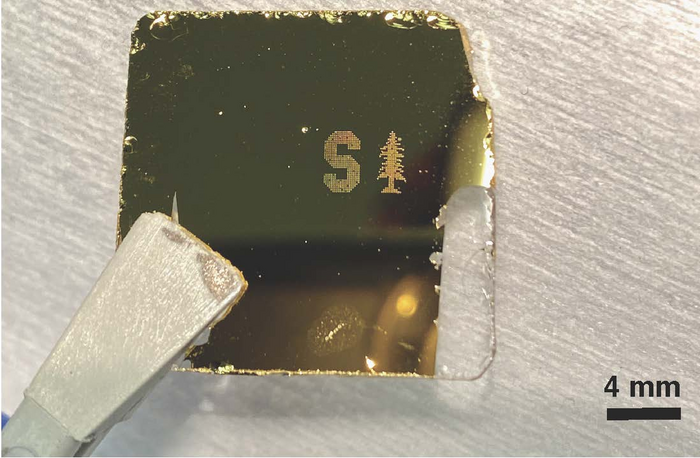In a remarkable breakthrough poised to transform the landscape of terahertz technology, researchers have successfully demonstrated 100% amplitude modulation depth in the terahertz frequency regime using a novel graphene-based tunable capacitance metamaterial. This achievement, recently published in Light: Science & Applications, marks a significant stride toward the practical deployment of terahertz devices with unprecedented modulation performance. Terahertz waves, straddling the gap between microwaves and infrared light, have long promised revolutionary applications in communications, imaging, and spectroscopy. However, controlling these waves with high efficiency and dynamic range has remained a formidable challenge — until now.
Central to this advancement is the innovative design of metamaterials engineered with graphene, a two-dimensional sheet of carbon atoms celebrated for its extraordinary electrical, mechanical, and optical properties. By integrating graphene into the metamaterial’s structure, the research team has unlocked the ability to electrically tune the capacitance of the system dynamically. This tunability directly translates to the precise modulation of terahertz wave amplitude, achieving the coveted 100% depth that signifies complete on-off switching capability, a feat unheard of in prior terahertz devices.
The physics underlying this breakthrough involves the intricate interplay between the metamaterial’s resonant modes and graphene’s gate-controlled conductivity. Graphene’s carrier density can be modulated by applying an external voltage, which effectively alters the capacitance in the metamaterial unit cells. When terahertz radiation is incident on this structure, the resultant electromagnetic response can be manipulated to either reinforce or suppress the transmitted wave, yielding a modulation depth that spans the full range from zero to one hundred percent. Such control permits dynamically adjustable filters, switches, and modulators that can operate at speeds compatible with future terahertz communication networks.
.adsslot_hXNluEpe7b{ width:728px !important; height:90px !important; }
@media (max-width:1199px) { .adsslot_hXNluEpe7b{ width:468px !important; height:60px !important; } }
@media (max-width:767px) { .adsslot_hXNluEpe7b{ width:320px !important; height:50px !important; } }
ADVERTISEMENT
This newly developed graphene-based metamaterial overcomes several limitations that have historically hindered terahertz modulators. Conventional modulators often suffer from low modulation depth, slow response times, or excessive power consumption. Graphene’s superior electronic mobility ensures rapid modulation, while the metamaterial architecture allows for compact device footprints. Together, these advantages pave the way for highly integrated terahertz components suitable for real-world applications, including ultra-high-speed wireless data transmission, non-invasive medical diagnostics, and chemical sensing.
From a fabrication perspective, the construction of the metamaterial involves depositing monolayer graphene onto a patterned dielectric substrate embedded with metallic resonators. These resonators are designed to exhibit strong capacitive behavior at terahertz frequencies. The application of a gate voltage modulates graphene’s Fermi level, which in turn adjusts the capacitive loading of the resonators. This ability to electrically govern the resonant characteristics brings unprecedented dynamism previously unattainable in passive metamaterial devices.
Equally impressive is the scalability and tunability of this platform. By tuning geometric parameters such as the size, shape, and spacing of the resonators, as well as varying the gate voltage, the device can be engineered to operate over a broad range of terahertz frequencies. This frequency agility enhances its suitability for diverse applications that demand flexibility, from security scanning to high-definition spectroscopy. Moreover, the use of graphene—a material compatible with existing semiconductor processing—ensures promise for seamless integration with other electronic and photonic components.
This innovation arrives at a crucial time when demand for high-speed, high-capacity wireless communication is skyrocketing globally. Terahertz frequencies are envisioned as the backbone of next-generation networks, capable of supporting data rates far beyond the capabilities of traditional microwave technologies. The ability to modulate terahertz signals fully and rapidly is essential to realize functional transmitters and receivers, and the graphene-tunable metamaterial presented here addresses this need with elegance and efficacy.
Beyond communications, the implications of such precise terahertz wave control extend into biomedical imaging. Terahertz waves can penetrate many non-conductive materials, providing unique contrast mechanisms for tissue characterization. A modulator capable of rapid amplitude shifts empowers enhanced imaging techniques such as gated time-resolved tomography, potentially improving diagnostic resolution without increasing system complexity or cost.
In addition, the chemical sensing community stands to benefit profoundly. Many molecules exhibit signature absorption lines in the terahertz domain. By tailoring modulation characteristics on demand, sensors can achieve greater sensitivity and specificity, discriminating between complex chemical mixtures. The electrical tunability offered by graphene metamaterials allows sensor platforms to adapt dynamically to varying detection scenarios, a feature critical for evolving industrial and environmental monitoring requirements.
The study’s success owes much to the multidisciplinary synergy between material science, electrical engineering, and photonics, reflecting the deep collaborative effort invested in pushing the boundaries of metamaterial functionality. The theoretical models guiding the design were validated through meticulous experimental work, resulting in a device that not only meets but exceeds longstanding performance benchmarks.
Looking forward, integration of such modulators into on-chip terahertz systems signals an exciting leap toward widespread practical adoption. Combining graphene’s remarkable electronic features with engineered metamaterials represents a powerful paradigm for future wave manipulation technologies, potentially impacting fields beyond terahertz science, including infrared and optical regimes.
Furthermore, the current research opens intriguing avenues for exploring nonlinear and quantum effects in graphene-based metamaterials, which could lead to even more advanced functionalities such as modulators with dynamic phase control, reconfigurable beam steering, and ultrafast optical switching. The adaptability and inherent speed of the graphene-tuned capacitance approach provide a fertile ground for innovation across a range of next-generation photonic devices.
In conclusion, this milestone achievement of achieving 100% amplitude modulation in the terahertz range with graphene-based tunable capacitance metamaterials delineates a new chapter in the active manipulation of electromagnetic waves. The seamless combination of graphene’s extraordinary electronic properties with the tailored resonant response of metamaterials signals a leap toward versatile, high-performance terahertz components. As the terahertz spectrum continues to emerge as a critical resource for communications, imaging, and sensing, innovations like this will be instrumental in unlocking its full potential, heralding a new era of technological advancement.
Subject of Research: Terahertz wave modulation using graphene-based tunable capacitance metamaterials.
Article Title: Achieving 100% amplitude modulation depth in the terahertz range with graphene-based tuneable capacitance metamaterials.
Article References:
Xia, R., Almond, N.W., Tadbier, W. et al. Achieving 100% amplitude modulation depth in the terahertz range with graphene-based tuneable capacitance metamaterials. Light Sci Appl 14, 256 (2025). https://doi.org/10.1038/s41377-025-01945-4
Image Credits: AI Generated
DOI: https://doi.org/10.1038/s41377-025-01945-4
Tags: amplitude modulation in terahertz technologycomplete on-off switching in terahertz systemsdynamic range terahertz devicesgraphene electrical propertiesgraphene in wave technologygraphene-based terahertz deviceshigh efficiency terahertz modulationmetamaterials for terahertz communicationterahertz frequency regime applicationsterahertz imaging and spectroscopyterahertz wave modulation breakthroughtunable capacitance metamaterials






